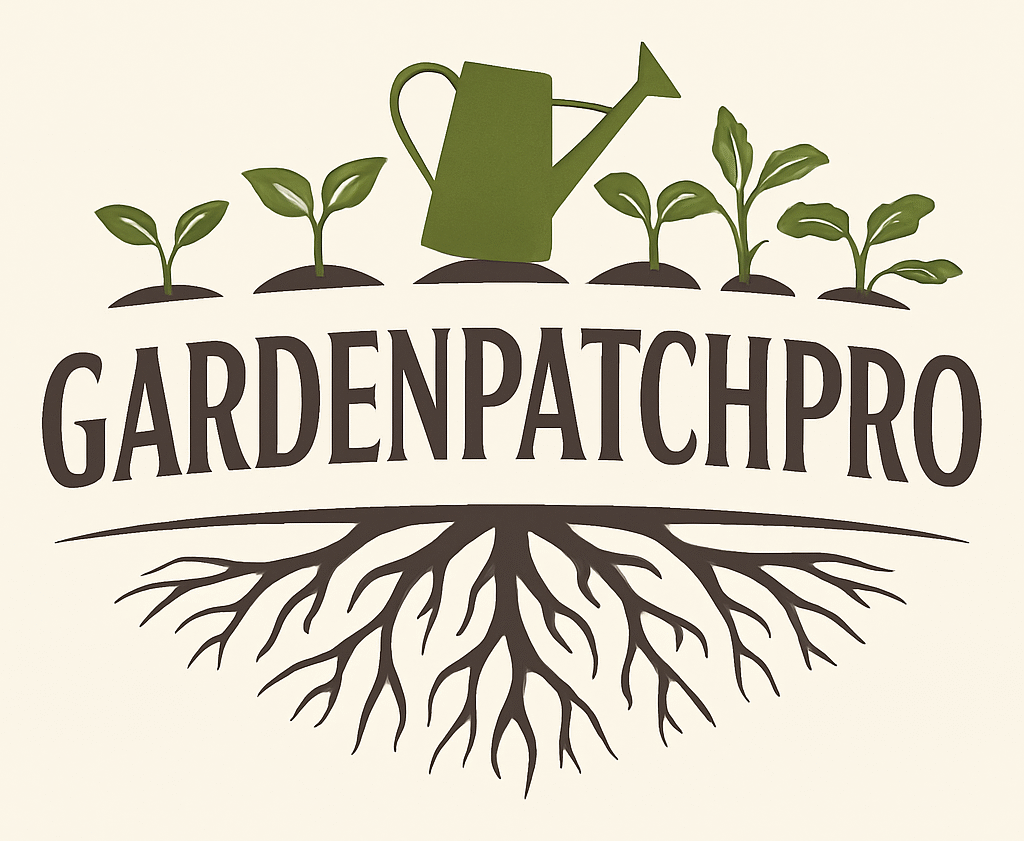12 Sloped Backyard Landscaping Ideas To Maximize Space And Enhance Curb Appeal
Sloped backyards can present challenges when it comes to landscaping. Uneven ground makes it harder to create usable outdoor spaces and can cause issues like soil erosion. However, with the right approach, these areas can be transformed into attractive and functional parts of a yard.

The key to successful sloped backyard landscaping is working with the natural contours of the land to create practical and beautiful designs. This allows for solutions that prevent erosion while making the most of limited space. Many creative ideas can help homeowners improve their sloped yards, regardless of the budget or slope size.
1) Terraced garden beds to prevent erosion and create planting levels
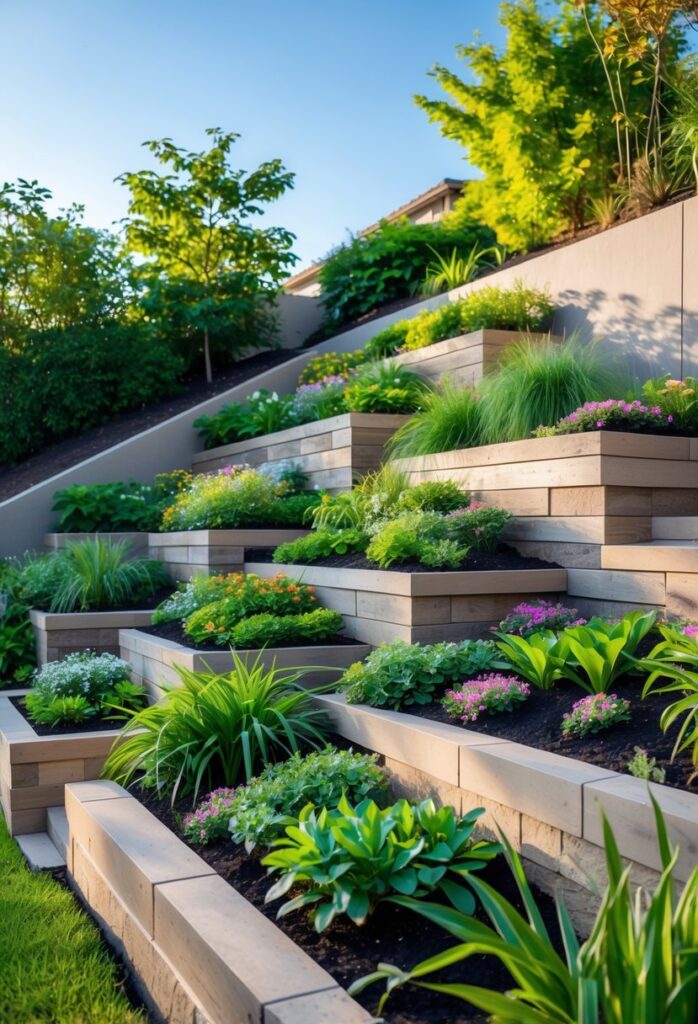
Terraced garden beds are a practical way to manage a sloped backyard. They help slow down water runoff, which reduces soil erosion. This makes the area more stable and easier to maintain.
These beds create flat, level planting areas on the slope. This allows gardeners to grow plants more effectively by giving roots a steady space to grow. It also helps with drainage, preventing water from pooling or washing away soil.
Building terraces involves using materials like wood, stone, or brick to form retaining walls. These walls hold soil in place and divide the slope into steps. Each step can be used to plant flowers, vegetables, or shrubs.
Terracing adds usable space to a yard that might otherwise be challenging to garden on. It turns a steep hill into a series of manageable, attractive garden beds. This method works well for both small and large slopes.
2) Retaining walls using natural stone for durability and aesthetics

Retaining walls made of natural stone offer both strength and visual appeal. They help hold back soil on slopes, preventing erosion while creating flat areas for planting or seating.
Natural stone blends well with different landscape styles, from rustic to modern. Its texture and color add a timeless look that fits most outdoor spaces.
These walls are long-lasting and require little maintenance when built correctly. Proper drainage is important to avoid water damage and maintain stability over time.
Natural stone walls can be built in various shapes and sizes. This flexibility allows homeowners to customize their backyard to suit their needs and style.
Besides structure, natural stone walls bring a natural feel to the yard. They often become focal points that enhance the overall landscape design.
3) Stone or wooden staircases to access different yard levels safely
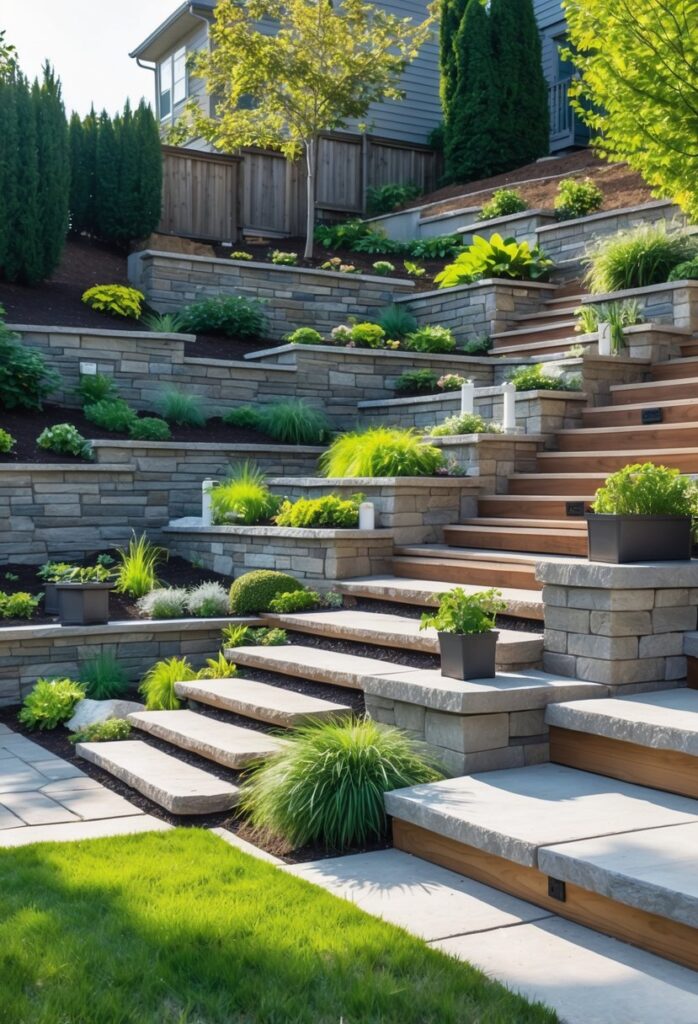
Stone or wooden staircases are effective ways to move between levels in a sloped backyard. They offer stable footing and reduce the risk of slipping on uneven or steep ground.
Stone steps are durable and blend well with natural surroundings. Using thick stone slabs with gravel or sand underneath can help ensure the stairs stay secure over time.
Wooden stairs can add warmth and a natural look to the yard. Proper anchoring deep into the soil is important to prevent movement or loosening as the ground shifts.
Both stone and wood stairs should have even step heights and wide treads. This makes climbing safer and more comfortable for people of all ages.
Building stairs on a slope requires attention to drainage. Water should not pool on the steps, or it could cause damage and increase slip hazards.
Well-constructed staircases improve access and usability of a sloped yard. They also help define different areas while adding visual interest to the landscape.
4) Multi-level seating areas integrated into the slope design
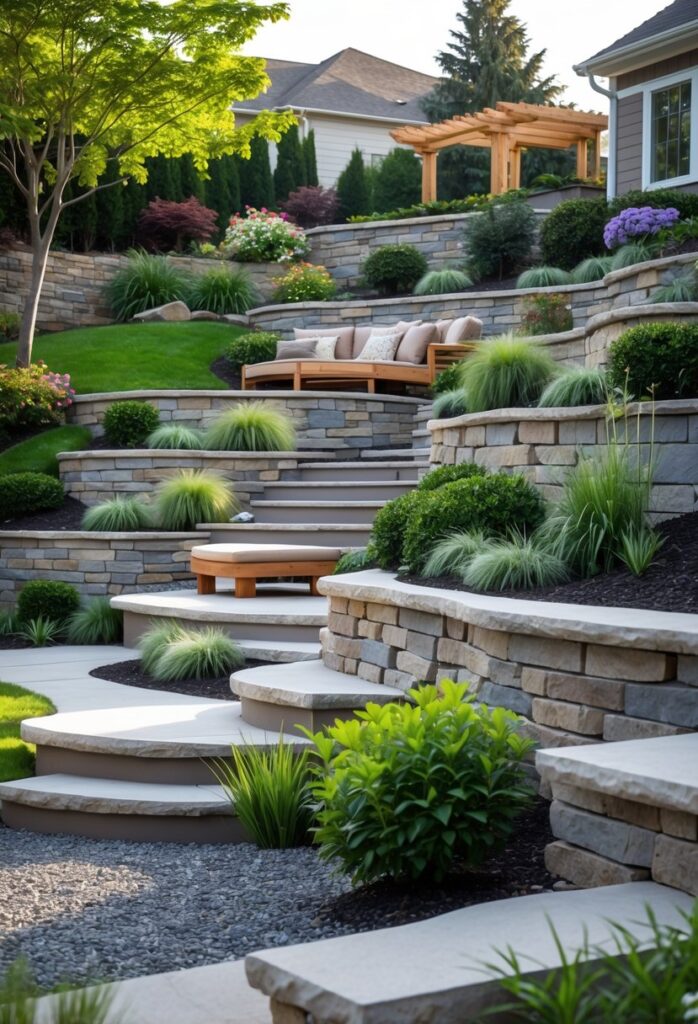
Multi-level seating makes good use of a sloped backyard by turning the incline into useful space. By building low retaining walls or terraces, seating areas can be created on different levels. This approach adds structure and function to uneven land.
These seating areas can be made from materials like wood, stone, or concrete. They can include benches built into retaining walls or standalone furniture placed on flat platforms. This creates comfortable spots for relaxing or socializing.
Integrating planters or garden beds alongside seating can soften hard edges and add greenery. It also helps blend the seating into the landscape. Adding cushions or outdoor pillows can improve comfort.
Paths or steps connecting each seating level improve access and safety. Lighting can highlight edges and create a pleasant atmosphere at night. Overall, multi-level seating makes a sloped yard more inviting and practical.
5) Planting ground covers like creeping juniper to stabilize soil

Planting ground covers is a practical way to protect sloped yards from soil erosion. Creeping juniper is a popular choice because its roots spread deep and wide. This helps hold the soil firmly in place, even during heavy rain.
Creeping juniper grows low and spreads across the ground. It creates a thick, green carpet that keeps soil from washing away. The plant stays green all year, adding color to the landscape through every season.
It thrives in many soil types, including rocky and dry areas. This makes creeping juniper a versatile option for difficult slopes. With little maintenance, it can prevent erosion while improving the look of the yard.
Using creeping juniper also reduces the need for more complicated erosion control methods. It is a natural and cost-effective solution. This plant can be an essential part of a stable, well-kept sloped backyard.
6) Use of decorative boulders as focal points and erosion control
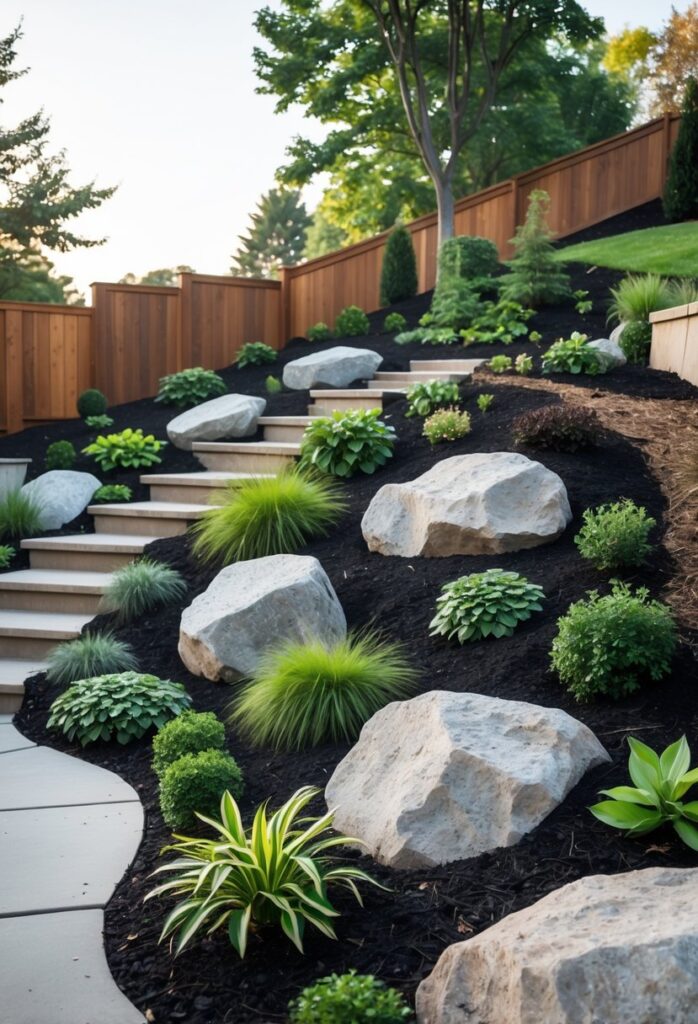
Decorative boulders are useful in sloped backyards for both visual interest and practical benefits. They can act as natural focal points, drawing the eye and adding structure to the landscape.
Using large boulders at key spots helps break up steep slopes. This makes the yard feel more balanced and layered.
Boulders also help control erosion. Their weight and placement slow water runoff and reduce soil loss on hillsides.
Smaller rocks can be used around larger ones to create natural-looking borders. This helps stabilize the soil while improving the yard’s appearance.
Choosing boulders of different sizes adds texture and depth to the landscape. It also makes the space look less uniform and more natural.
Overall, boulders are a strong option for homeowners who want both style and function in a sloped backyard.
7) Incorporating a rain garden at the slope base for water management
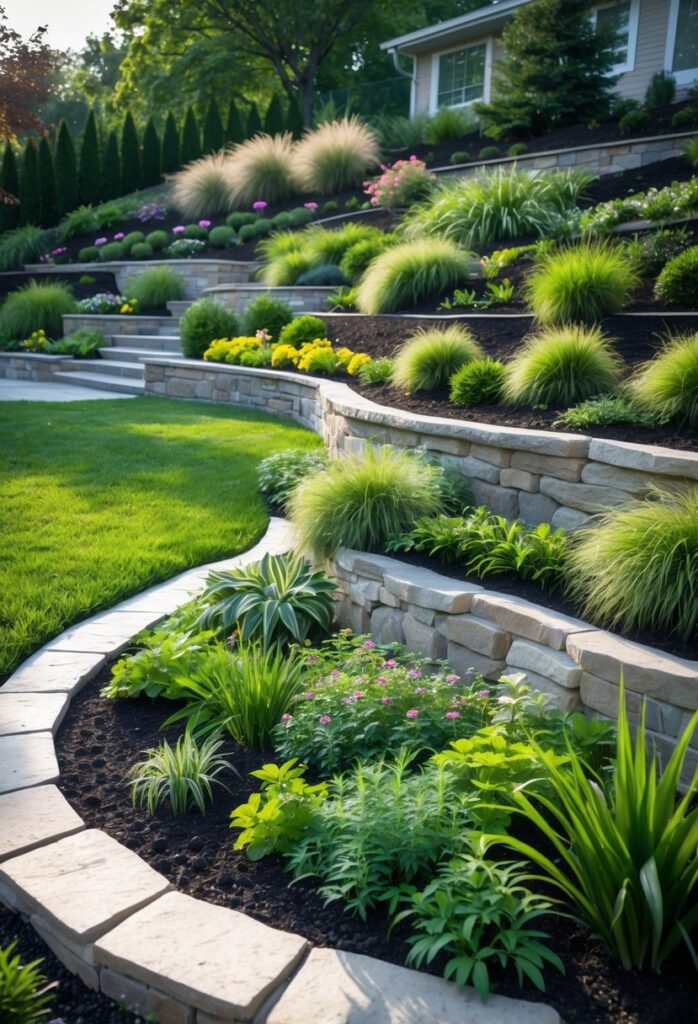
A rain garden placed at the base of a slope helps manage stormwater effectively. It captures runoff water, allowing it to soak into the ground rather than flowing away and causing erosion.
Rain gardens work best on gentle slopes, typically between 2% and 12%. This allows water to flow naturally without pooling or causing damage. Very steep slopes may require other solutions to control erosion.
Plants in the rain garden filter pollutants from the water. They also help slow down the flow, reducing soil loss. Choosing native plants adapted to wet conditions improves the garden’s performance.
Adding layers of mulch and soil helps absorb water and supports plant roots. A properly designed rain garden minimizes standing water and directs excess runoff safely.
This method not only controls water but also provides a habitat for local wildlife. It can enhance the look of the backyard while solving drainage problems at the same time.
8) Installing an infinity-edge pool to emphasize elevation changes

An infinity-edge pool works well on a sloped backyard because it uses the natural drop to create a smooth water flow over one edge. This design makes the water appear to merge with the horizon or the landscape below.
The elevation change is essential for the pool to function properly. A slope of at least a few feet is needed to allow water to spill over the edge and collect in a basin below.
This type of pool adds depth and visual interest to the yard. It highlights the slope rather than hiding it. The water flowing over the edge draws attention to the difference in height.
Infinity pools require careful planning and construction. The catch basin and pump system must be designed to handle the water flow efficiently.
Increased costs may come with this design. However, it provides a clean and modern look that many find appealing. It creates a peaceful, open feel that fits well with sloped yards.
9) Stepped pathways with gravel or pavers for functional navigation
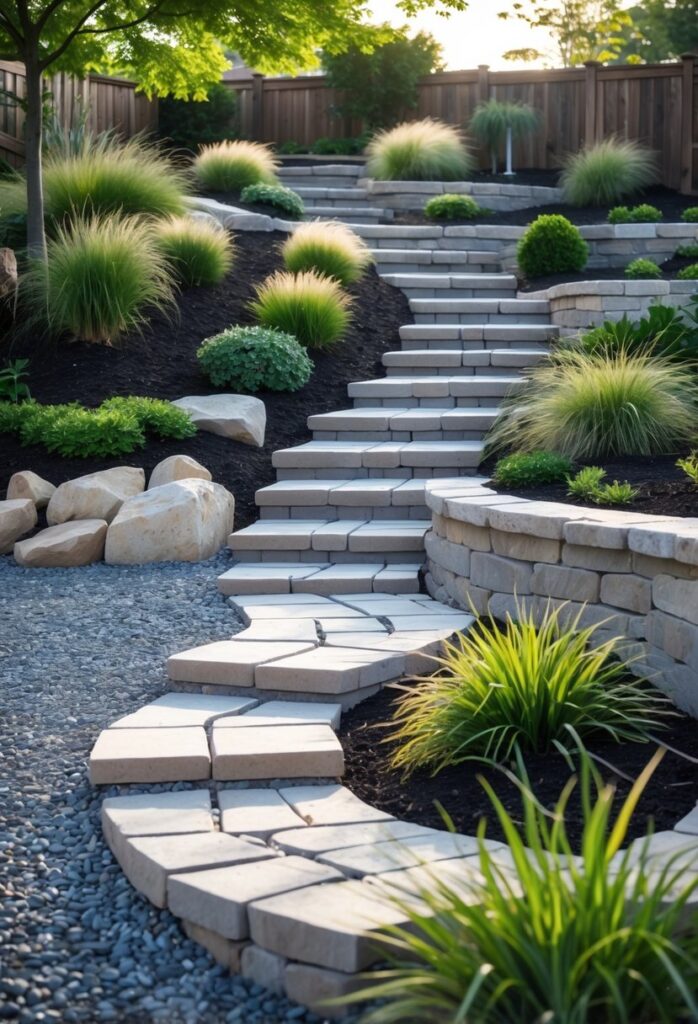
Stepped pathways help people move safely up and down a sloped backyard. Using gravel or pavers for these steps creates a stable walking surface that reduces slipping hazards. Gravel is affordable and blends well with natural surroundings.
Pavers offer a clean and organized look. They come in different shapes, sizes, and colors to match the yard’s style. Both materials work well for creating clear pathways that divide steep areas into manageable sections.
Combining stepping stones with gravel is a popular choice. The stones act as solid steps while the gravel fills gaps, improving drainage and preventing erosion. This mix also provides good traction on uneven ground.
Maintaining these pathways is simple. Gravel can be topped up when it thins out, and pavers only need occasional cleaning. Properly designed stepped paths make steep yards more accessible and visually appealing.
10) Raised vegetable or herb gardens on flat terraces

Raised gardens on flat terraces work well for sloped yards. Creating even, level spaces helps hold soil and water in place. This prevents erosion and gives plants a stable area to grow.
Using wood, stone, or bricks, terraces form flat beds that are easy to access. These beds can hold vegetables like tomatoes, peppers, and herbs. The raised design improves drainage and soil quality for healthier plants.
Terraced raised beds also make it easier to organize plants and maintain the garden. They reduce soil runoff during heavy rains and help capture rainfall. This setup can turn a steep slope into productive growing areas with neat rows of crops.
Raised terraces are sturdy and can save space by stacking planting areas vertically. They require some initial effort but offer long-term benefits for garden care and plant growth on hillsides.
11) Outdoor lighting along stairs and terraces for safety and ambiance
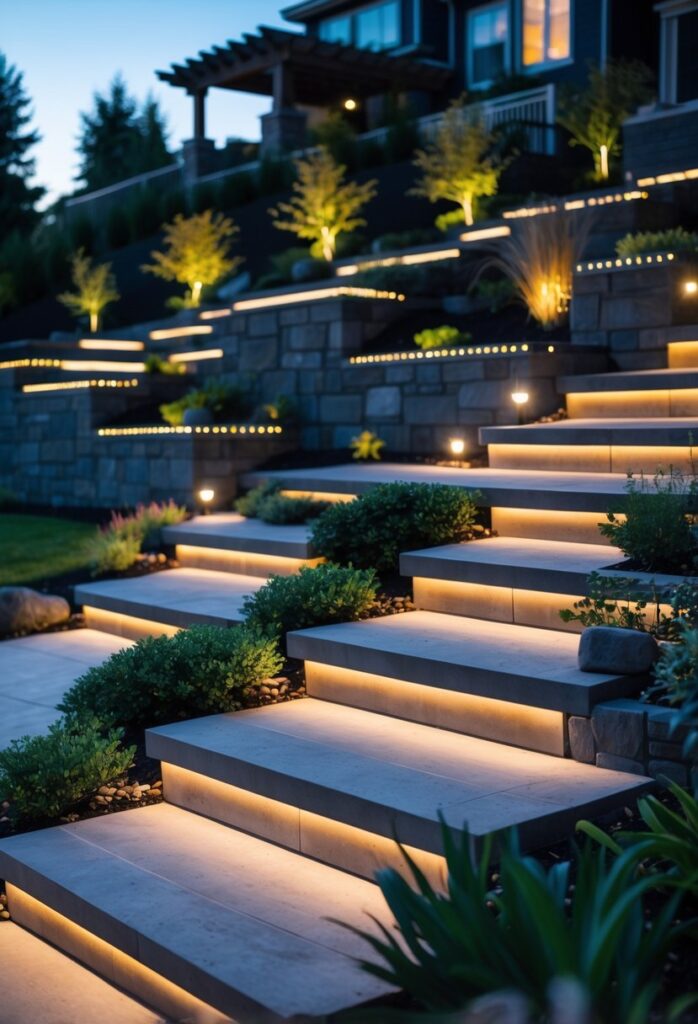
Adding outdoor lighting along stairs and terraces improves safety by clearly marking steps and edges. This helps prevent trips and falls, especially after dark.
Lighting can be placed under stair treads, along railings, or recessed into walls. These options provide enough light without being too bright or harsh.
LED strip lights and small recessed fixtures are popular choices. They offer energy efficiency and a clean, modern look.
Besides safety, lighting adds ambiance to outdoor spaces. Warm white lights create a cozy and inviting atmosphere on terraces and patios.
Positioning lights carefully also enhances the overall design of sloped yards. It highlights textures, shapes, and landscaping features.
Solar-powered lights and low-voltage systems are easy to install. They reduce the need for complex wiring while keeping the space well lit.
Proper outdoor stair and terrace lighting balances function and style. It makes using outdoor areas safer and more enjoyable at night.
12) Building a fire pit area on a flat section of the slope

They should first find or create a flat space on the slope. This might mean digging into the slope to make a level area.
A flat spot is important so the fire pit sits evenly. This helps keep the fire safe and reduces smoke problems.
Retaining walls can help hold back the earth and prevent soil from shifting. These walls also add structure and can make the area look tidy.
Once level, the space can be covered with materials like stone, gravel, or pavers. These options are durable and fit well around a fire pit.
It is best to plan enough room for seating around the fire pit. This allows space for chairs and movement without feeling cramped.
Good drainage should be considered. Water should not collect near the fire pit to avoid damage and safety risks.
Key Considerations Before Landscaping a Sloped Backyard
Proper planning is essential before starting any landscaping on a sloped backyard. Understanding the soil condition, water flow, and plant suitability can prevent common problems like erosion and poor drainage.
Assessing Soil Erosion Risks
Soil erosion is a major concern on sloped yards. Loose soil can wash away during heavy rain, damaging plants and structures. Identifying areas with bare soil or signs of runoff is important.
To control erosion, using retaining walls, terraces, or ground covers can stabilize the slope. Mulching exposed areas also helps by protecting soil from rain impact. Regularly checking for erosion and adding soil or plants can keep the landscape intact.
Understanding Drainage and Water Flow
Water naturally flows downhill, which can create pooling or dry spots depending on the yard’s shape. Knowing the direction and speed of water flow helps avoid water damage and plant loss.
Installing drainage solutions like french drains or swales can redirect excess water. It is also important to avoid blocking natural water paths. Proper grading and using permeable materials reduce water buildup.
Selecting Appropriate Plants for Slopes
Choosing plants that suit slope conditions improves success. Deep-rooted plants help hold soil better than shallow-rooted ones. Native plants are often best because they adapt well to local climate and soil.
Plants that tolerate varying moisture levels and can grow in uneven soil areas work well. Combining groundcovers, shrubs, and trees creates layers that protect against erosion and add beauty. Avoid plants that need consistently wet or dry soil unless drainage is fixed.
Maintenance and Long-Term Care
Sloped backyards require specific care to keep plants healthy and prevent soil erosion. Proper strategies help manage weeds and maintain stability through changing seasons. Regular attention ensures the landscape stays functional and attractive over time.
Preventing Weeds on Inclined Areas
Weeds can quickly take over sloped areas, causing problems like soil instability and a messy appearance. To prevent this, using mulch or ground covers is effective. These block sunlight, stopping weed seeds from growing.
Applying a weed barrier fabric under soil or mulch can also reduce weed growth. Regularly checking for weeds and pulling them out early helps stop them from spreading.
Choosing plants that form a dense root system helps crowd out weeds naturally. Native plants often work well because they adapt to local conditions and require less care.
Seasonal Maintenance Tips for Sloped Terrains
Seasonal care is important on slopes to avoid erosion and keep plants healthy. In spring, they should inspect drainage systems like swales or French drains to make sure water flows correctly.
Summer calls for watering deeply but less often to encourage strong roots. Mulch may need replenishing to retain moisture and block weeds.
In fall, preparing the slope for winter means removing dead plant material and checking retaining walls or terraces for stability. Winter may require monitoring for heavy snow or ice buildup that can damage the landscape.
Adjusting maintenance with the seasons helps protect the slope from damage and promotes healthy growth year-round.
Frequently Asked Questions
These questions address common concerns about managing sloped backyards. They cover cost-saving strategies, easy-care landscaping options, sources for visual ideas, and practical solutions for small or challenging spaces.
How do I landscape a sloped backyard on a budget?
Using materials already on-site, like logs or stones, helps cut costs. Terraced garden beds and planting ground covers such as creeping juniper can reduce erosion without expensive installations. Simple retaining walls made from natural stone offer both strength and good looks at a reasonable price.
What are some low-maintenance sloped backyard landscaping ideas?
Ground covers that spread quickly and need little care work well. Retaining walls made with durable materials, like stone, reduce ongoing upkeep. Multi-level seating areas built into the slope cut down on lawn space, which lowers maintenance needs.
Can you show pictures of landscaped sloped backyards for inspiration?
Visual galleries online often feature terraced beds, stone staircases, and integrated seating areas. Many websites and garden platforms offer extensive photo collections showing before and after views of sloped backyard projects.
What are the best before and after transformations of sloped backyards?
The most effective transformations use terraces to create flat planting zones and retaining walls to stabilize soil. Adding stone or wooden staircases boosts accessibility. These changes turn steep, unusable slopes into functional, attractive outdoor areas.
What are effective landscaping solutions for small sloped backyards?
Compact terraced beds maximize planting space without overcrowding. Narrow retaining walls help control erosion in tight spots. Stone staircases sized for small yards allow safe movement between levels without wasting space.
What are some creative DIY ideas for landscaping a sloped backyard?
Building simple retaining walls with stones or logs is a DIY-friendly project. Constructing wooden staircases from basic lumber helps create access paths. Planting fast-growing ground covers provides erosion control that can be maintained without special tools.
